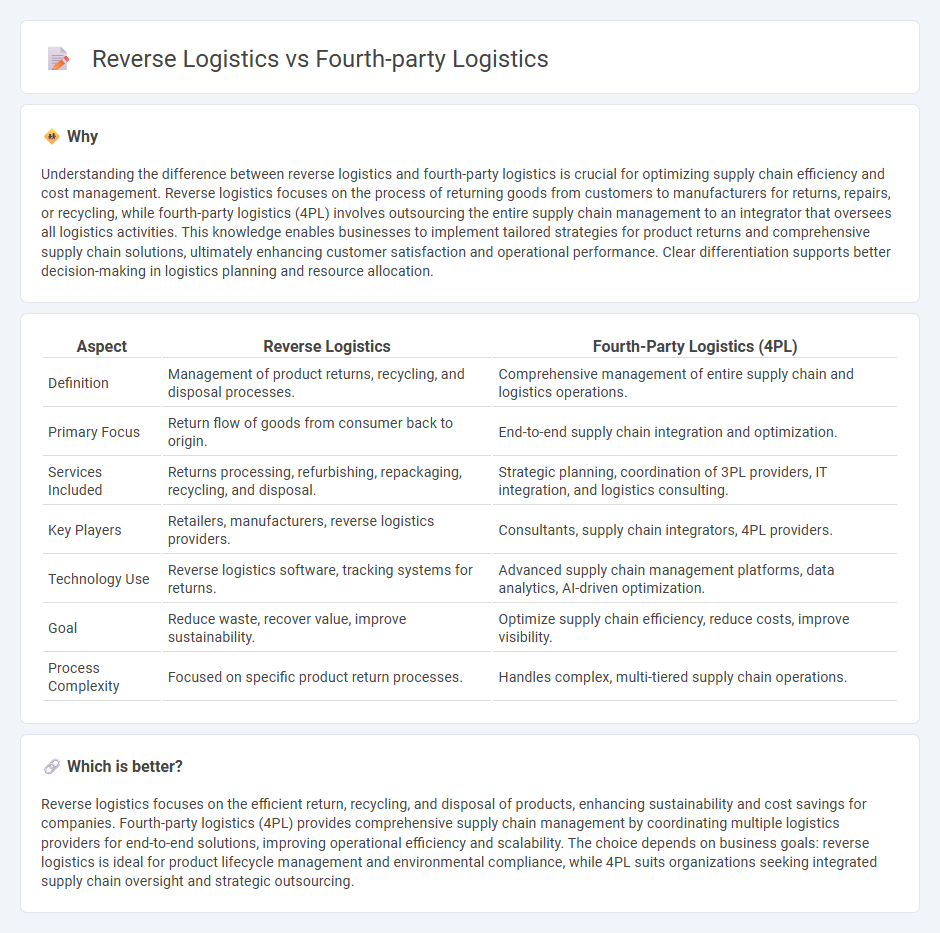
Reverse logistics focuses on managing the return and recycling processes of products to optimize reuse and minimize waste, while fourth-party logistics (4PL) integrates and manages comprehensive supply chain solutions by overseeing multiple logistics providers. Both strategies enhance operational efficiency but address different aspects of the supply chain lifecycle, with reverse logistics emphasizing returns management and 4PL centering on end-to-end supply chain coordination. Explore the differences and benefits of reverse logistics versus fourth-party logistics to optimize your business operations.
Why it is important
Understanding the difference between reverse logistics and fourth-party logistics is crucial for optimizing supply chain efficiency and cost management. Reverse logistics focuses on the process of returning goods from customers to manufacturers for returns, repairs, or recycling, while fourth-party logistics (4PL) involves outsourcing the entire supply chain management to an integrator that oversees all logistics activities. This knowledge enables businesses to implement tailored strategies for product returns and comprehensive supply chain solutions, ultimately enhancing customer satisfaction and operational performance. Clear differentiation supports better decision-making in logistics planning and resource allocation.
Comparison Table
| Aspect | Reverse Logistics | Fourth-Party Logistics (4PL) |
|---|---|---|
| Definition | Management of product returns, recycling, and disposal processes. | Comprehensive management of entire supply chain and logistics operations. |
| Primary Focus | Return flow of goods from consumer back to origin. | End-to-end supply chain integration and optimization. |
| Services Included | Returns processing, refurbishing, repackaging, recycling, and disposal. | Strategic planning, coordination of 3PL providers, IT integration, and logistics consulting. |
| Key Players | Retailers, manufacturers, reverse logistics providers. | Consultants, supply chain integrators, 4PL providers. |
| Technology Use | Reverse logistics software, tracking systems for returns. | Advanced supply chain management platforms, data analytics, AI-driven optimization. |
| Goal | Reduce waste, recover value, improve sustainability. | Optimize supply chain efficiency, reduce costs, improve visibility. |
| Process Complexity | Focused on specific product return processes. | Handles complex, multi-tiered supply chain operations. |
Which is better?
Reverse logistics focuses on the efficient return, recycling, and disposal of products, enhancing sustainability and cost savings for companies. Fourth-party logistics (4PL) provides comprehensive supply chain management by coordinating multiple logistics providers for end-to-end solutions, improving operational efficiency and scalability. The choice depends on business goals: reverse logistics is ideal for product lifecycle management and environmental compliance, while 4PL suits organizations seeking integrated supply chain oversight and strategic outsourcing.
Connection
Reverse logistics enhances supply chain efficiency by managing product returns, recycling, and disposal, which directly supports fourth-party logistics (4PL) providers in delivering end-to-end supply chain solutions. Fourth-party logistics firms integrate reverse logistics processes to optimize inventory recovery, reduce waste, and improve sustainability metrics for clients. The synergy between reverse logistics and 4PL enables seamless coordination of reverse flows and value-added services within complex, multi-tiered logistics networks.
Key Terms
Supply Chain Integration
Fourth-party logistics (4PL) integrates multiple supply chain components, managing end-to-end operations and ensuring seamless coordination among suppliers, manufacturers, and distributors for optimized efficiency. Reverse logistics focuses on returning products from consumers to manufacturers, handling returns, recycling, and disposal, enhancing sustainability and cost savings. Explore the differences and synergies between 4PL and reverse logistics to improve your supply chain integration strategies.
Returns Management
Fourth-party logistics (4PL) integrates multiple supply chain functions, including reverse logistics, which specifically targets returns management by streamlining product flow backward from customers to manufacturers. Reverse logistics enhances customer satisfaction through efficient returns processing, refurbishment, and disposal, while 4PL providers coordinate these activities within a broader supply chain strategy. Explore how specialized 4PL solutions can optimize returns management and improve overall logistics efficiency.
Outsourcing
Fourth-party logistics (4PL) involves outsourcing the entire supply chain management to a specialized provider who integrates multiple logistics services, including transportation, warehousing, and inventory management. Reverse logistics focuses on the return process, handling product returns, recycling, and disposal, often outsourced to experts to efficiently manage reverse flows and minimize costs. Discover how outsourcing these logistics functions can optimize operations and enhance supply chain performance.
Source and External Links
Fourth Party Logistics: Definition, Advantages, and ... - Fourth-party logistics (4PL) is an integrated supply chain management service where a single provider oversees and optimizes the entire logistics process, managing multiple third-party logistics (3PL) providers to deliver a holistic and streamlined solution.
What Is Fourth-Party Logistics (4PL)? 2025 Guide - A 4PL provider acts as a control tower for logistics, managing end-to-end supply chain networks and infrastructure, often coordinating multiple 3PL warehouses or independently overseeing all supply chain nodes for comprehensive fulfillment and logistics strategy.
What is 4PL Logistics? 4th Party Logistics Meaning - Fourth-party logistics fully outsources supply chain management to one partner who handles coordination of warehouses, shipping, freight, and other logistics services, providing increased efficiency and cost savings by consolidating multiple providers into a single integrated solution.
 dowidth.com
dowidth.com